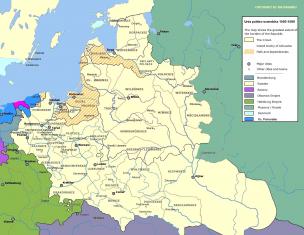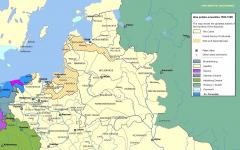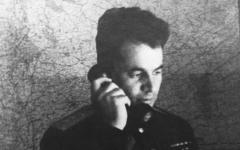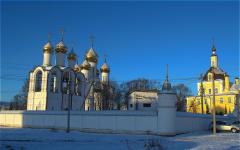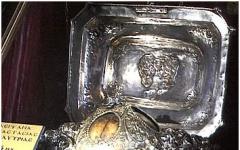This article provides examples cable magazine ov completed in Autocad program in dwg format in accordance with GOST 21.613-2014 and GOST 21.607-2014 for working drawings of EM and EN brands.
The cable log must be made according to Form 7 in accordance with GOST 21.613-2014 for working drawings of power electrical equipment (EM brand), see Fig. 1. This GOST replaces GOST 21.613-88.
In principle, in the form presented, everything is intuitive; no additional explanation is required. In the column “Cable route section, wires” for Form 7 indicate the designations of the route sections in accordance with the electrical network laying plan. Include cable magazine
if necessary, the composition of the main sets of working drawings of the EM brand is necessary, see section 4, paragraph 4.3 of GOST 21.613-2014.
Fig. 1 – Cable magazine for laying using the route method for working drawings of the EM brand For working drawings of external electric lighting (EN brand), the cable log is made according to Form 4 in accordance with GOST 21.607-2014, see Fig. 2. It is allowed not to perform a cable log if all the data contained in the cable log is displayed on schematic diagram
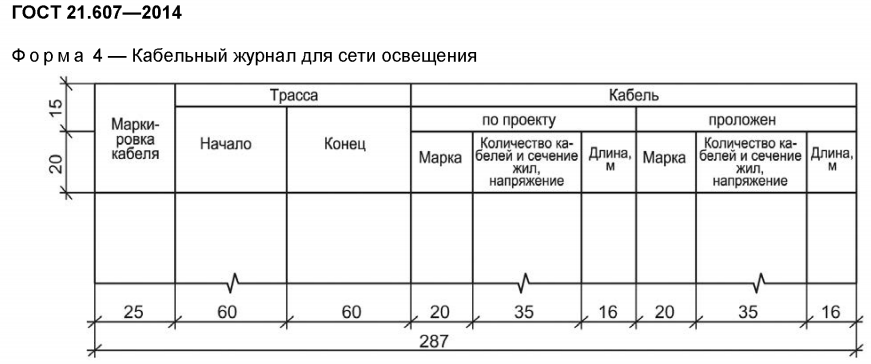
lighting networks.
Fig. 2 – Cable magazine for laying using the route method for working drawings of the EN brand Include As we see
- for outdoor lighting has significant differences from a cable log for power electrical equipment, namely:
- ● the column “Cable route section, wire” is missing;
- ● the inscription in the cable designation column has been changed to “Cable marking”;
- ● the column where the number of cables and cross-section is indicated has been changed to “Number of cables and cross-section of cores, voltage”;
- ● the inscription in the “Cable” line has been changed;
● the width of the “Length, m” column has been increased by 1 mm.
As a result, the width of the entire cable log table was 287 mm instead of 395 mm.

To avoid drawing the cable log forms from scratch, I am attaching examples of cable logs for the EM and EN brands, drawn in accordance with Form 7 and Form 4. The cable log forms are made in the form of a table, which makes drawing up the log easier. Allows you to quickly add and remove rows. In Fig. 3 you can see an example of a completed cable log in Autocad.
Fig. 3 – Example of a cable magazine for laying using the route method made in Autocad
- 1. GOST 21.613-2014 – Power electrical equipment. Working drawings in PDF format.
- 2. GOST 21.607-2014 – External electric lighting. Working drawings in PDF format.
- 3. Examples of cable logs in accordance with GOST 21.613-2014 and GOST 21.607-2014 in DWG format.
Please note that this article has been revised, since GOST 21.613-88 is no longer valid. An example of a cable magazine for outdoor lighting has been added, and explanations have been added for the implementation of a cable magazine for the EM and EN brands. We ask those who downloaded the cable magazine template early to replace it with a more new version in accordance with the above guests. We apologize for misleading you.

The pipe procurement list is carried out according to Form 8 in the following cases:
For electrical networks, where the laying of cables and wires in metal pipes predominates and where the volume of pipe gaskets determines the feasibility of procuring pipe elements in the MEZ;
For electrical networks laid in pipes in the foundations of complex equipment.
When filling out the pipe procurement list, in the column “Pipe route section” indicate:
Lengths of pipe sections between the vertices of the corners in meters;
Angle values in degrees and bending radii in millimeters;
Pipe procurement list

If there are normalized pipe elements, the pipe procurement list is carried out in the same form, but in the column “Pipe route section” the following is indicated:
The lengths of normalized straight pipe sections, and in necessary cases- length of the additional segment in meters;
Types of connecting angles indicating the bending angle in degrees;
Designations of broaching boxes and pipe blocks;
When compiling a pipe procurement list, the columns of the cable and pipe log relating to pipes are not filled out, but provide a link to the pipe procurement list.
The pipe procurement list contains a table of pipe requirements according to Form 5.
2.12. The list of filling pipes with cables and wires is carried out according to Form 9 in cases where a cable log and a pipe procurement list are compiled separately.
List of filling pipes with cables and wires
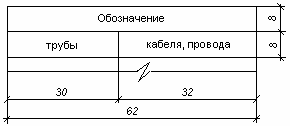
2.13. When filling out the column “Length of wires, cables and pipes” on schematic diagrams and in cable and pipe logs, indicate the length, taking into account the allowance for bends, turns and waste.
2.14. When making working drawings of power electrical equipment on a computer, the forms of the output documents should be as close as possible to the forms given in the standard. It is permissible to make schematic diagrams of the supply and distribution networks in the form of tables, and the tables must contain all the technical data provided for in Forms 2 and 3.
3. Drawings of electrical installation structures and dimensional drawings of the switchgear
3.1. Drawings of electrical installation structures intended for the installation of electrical equipment and laying electrical networks are carried out in cases where there are no corresponding factory-made products, standard drawings of electrical installation structures and drawings of electrical installation structures for reuse.
The drawing of the electrical installation structure is usually carried out on a scale of 1:5, 1:10 or 1:20.
On the drawing of the electrical installation structure, a specification is placed in the forms GOST 2.106 and GOST 2.113.
3.2. All electrical installation structures to be manufactured in the MEZ according to standard drawings, re-use drawings and newly developed drawings are included in the list of electrical installation structures to be manufactured in the MEZ in Form 10.
Energy
The cable log describes the marking of each cable from where and where it goes, its brand, the length of the cable line and its purpose. Purpose: All necessary information about cables can be presented directly on the diagrams: you can indicate the brand, length, and method of laying the cable. However, when building a sufficiently large system, in order to avoid overloading the drawings, it is more convenient to put this data in a separate table, leaving only the designations assigned to the cables on the diagrams. During installation, the following information is entered into the cable log: number...
The purpose of the cable magazine and what is reflected on the sheets of the cable magazine.
The cable log describes the marking of each cable, where it comes from and where it goes, its brand, the length of the cable line and its purpose. In addition, the as-built documentation includes a description of the front side (facade) of the cross-connect, which includes the purpose of each passive device (patch panel or cross-connect panel), as well as the connecting block or module.
Purpose:
All necessary information about cables can be presented directly on the diagrams: you can indicate the brand, length, and method of laying the cable. On the diagrams you can trace where the cable comes from and where it goes. However, when building a sufficiently large system, in order to avoid overloading the drawings, it is more convenient to place this data in a separate table, leaving only the designations assigned to the cables on the diagrams.
During installation, the following information is recorded in the cable log:
- number of the drum from which the cable was taken for installation, manufacturer and date of manufacture of the cable; link to protocols (acts) on acceptance and factory testing of the cable;
- defects detected during acceptance, transportation and laying of the cable, as well as during testing of the cable end (kappa);
- test results of protective grounding, insulation resistance, leakage currents, indicating the time and persons who carried out the tests;
- laying time, temperature environment during installation, method and result of cable heating, placement of couplings, their design and methods of cutting cable ends (dry epoxy; casting with MB-70 cable compound; retaining with pressed sleeves; improved end
- etc.).
The logs are accompanied by a high voltage cable test report.
All deviations from the project that occurred during the cable laying process are also recorded in the cable log.
The explanatory note provides justification for the choice of cable brands adopted by the project; The note indicates the purpose and load of the cable lines, and provides special instructions for the installation and laying of cables.
As well as other works that may interest you |
|||
| 29263. | Mentality as the core of a cultural-historical type | 31.5 KB | |
| Cultural pictures of the world. PICTURE OF THE WORLD is a system of intuitive ideas about reality. Each period of historical time has its own picture of the world. It is possible to identify a universal picture of the world that is characteristic of all humanity. | |||
| 29264. | Intercultural communications | 35.5 KB | |
| Necessary conditions and structural components of sociocultural communication is the presence common language the subjects of communication have channels for transmitting information, the rules of communication are semiotic, ethical. However, only actions carried out with the special purpose of communication are actually communicative. In his opinion, all participants in communication are guided by generalized intersubjectively understood norms of communication, which, together with communicative competence and the presence of rational motives, makes... | |||
| 29265. | Confucian-Taoist type of culture | 36.5 KB | |
| Its first basis is the teachings of Confucius and the second is Taoism, the teachings of the Taoists, as well as Buddhism, but it differs from Indian. Confucianism is the teaching of Confucius, a Chinese sage who lived in the 7th century BC. Confucius created the doctrine of the ideal man, the doctrine of the noble man, he must be humane, merciful, respectful, honest, etc. Thus, Confucianism is more of an ethical teaching than a religion, but it is also a teaching about the state. | |||
| 29266. | Modern culture | 98.5 KB | |
| Kagan CULTURE of the 17th century European cultural history is based on the ancient city-polis on the polis genotype. On this basis there were character traits bourgeois culture: The anthropocentric nature of culture is based on the thought of the ancient Greek philosopher Protagoras. Man is the measure of all things. Personal freedom is denounced as the original symbol and becomes the main value of Western culture. Innovative innovation innovation the nature of culture: a general orientation towards changing the usual way of thinking. | |||
| 29267. | CULTURE AND NATURE (according to M.S. Kagan) | 36 KB | |
| Marx: metabolism between man and nature; practically spiritual relationships that develop in the everyday consciousness of people in their Everyday life are expressed in a fantastic transformation of the real world and are objectified in the mythology of religion and art; spiritual-theoretical relationships that are expressed in the knowledge of the laws of nature and receive their highest expression in the sciences of nature and in the value understanding of nature, which is developed in the sphere of ideology. The spheres of manifestation of the relationship between culture and nature can be... | |||
| 29268. | CULTURAL NORM | 30 KB | |
| There are norms that are universal, national, class, group, and interindividual. Norms differ from each other in the level of mandatory implementation and in the degree of freedom of choice. There are norms whose mandatory nature is unambiguous and definite, up to the application of strict sanctions, the implementation of legal norms, norms of technical activity in industrial production, etc. The effect of any norm is not absolute; the norm experiences a period of emergence of approval, then loses stability and begins to collapse. | |||
| 29269. | CULTUROGENESIS | 27.5 KB | |
| The essence of cultural genesis lies in the process of constant self-renewal of culture, not only by the method of transformational variability already existing forms and systems, but also through the emergence of new phenomena that did not exist in culture before. Culturogenesis is not a one-time event of the origin of culture in the era of primitive antiquity of mankind, but is a process of constant generation of new cultural forms and systems. From the perspective evolutionary theory The main reason for cultural genesis is the need to adapt human communities to... | |||
| 29270. | CULTUROLOGY. Philosophy of culture | 29.5 KB | |
| The subject of cultural studies. Many theoretical studies are carried out at the intersection of philosophy of culture and cultural studies. First of all, there is a division of cultural studies. In fundamental cultural studies, social anthropology, cultural anthropology, historical culturology, psychological anthropology, cultural semantics, etc. can be distinguished. | |||
| 29271. | Ancient Egyptian, ancient, biblical, Slavic, East Asian mythological systems | 59 KB | |
| The Pantheon system of all the gods of Egyptian deities includes several historical layers. The most ancient gods had an identity with animals: Horus the falcon Ra with the head of a falcon Sekhmet the lioness Anubis the jackal, etc. One of the main gods in Ancient Egypt Osiris was considered. The Egyptians performed an annual ritual in honor of God: an image of Osiris made of clay was sown with grain and covered with green shoots for the holiday. | |||
There are three forms of cable logs:
- Cable log for the supply network in accordance with GOST 21.608-84 in form 6;
- Cable and pipe log in accordance with GOST 21.613-88 in form 6;
- Cable log for laying using the route method in accordance with GOST 21.613-88 in form 7.
Execute and design cable logs in Word, Excel and AutoCAD. Or jointly in two of these programs.
1. Compiling a cable log in Excel or Word and printing on forms
This is the most ancient method, which appeared during the transition from manual drawing to computers. The cable log was compiled in Excel, because For a person who previously drew everything by hand, Excel is just a ready-made table. In AutoCAD, using lines and text, we drew the frame and the title block (the first sheet and subsequent ones). After this, the forms were printed: one first sheet and the required number of subsequent ones. These printed forms were then inserted back into the printer and the cable log was printed on them.
They acted in the same way with an explanatory note or when designing a cable magazine in Word. Here's a manual photoshop
It is worth noting that this method of performing cable logs is very rare at the moment.
2. Drawing up and designing a cable log in Excel
There were people who were not happy with the exercises with printers and making collages. They went ahead and made the frame and title block in Excel.
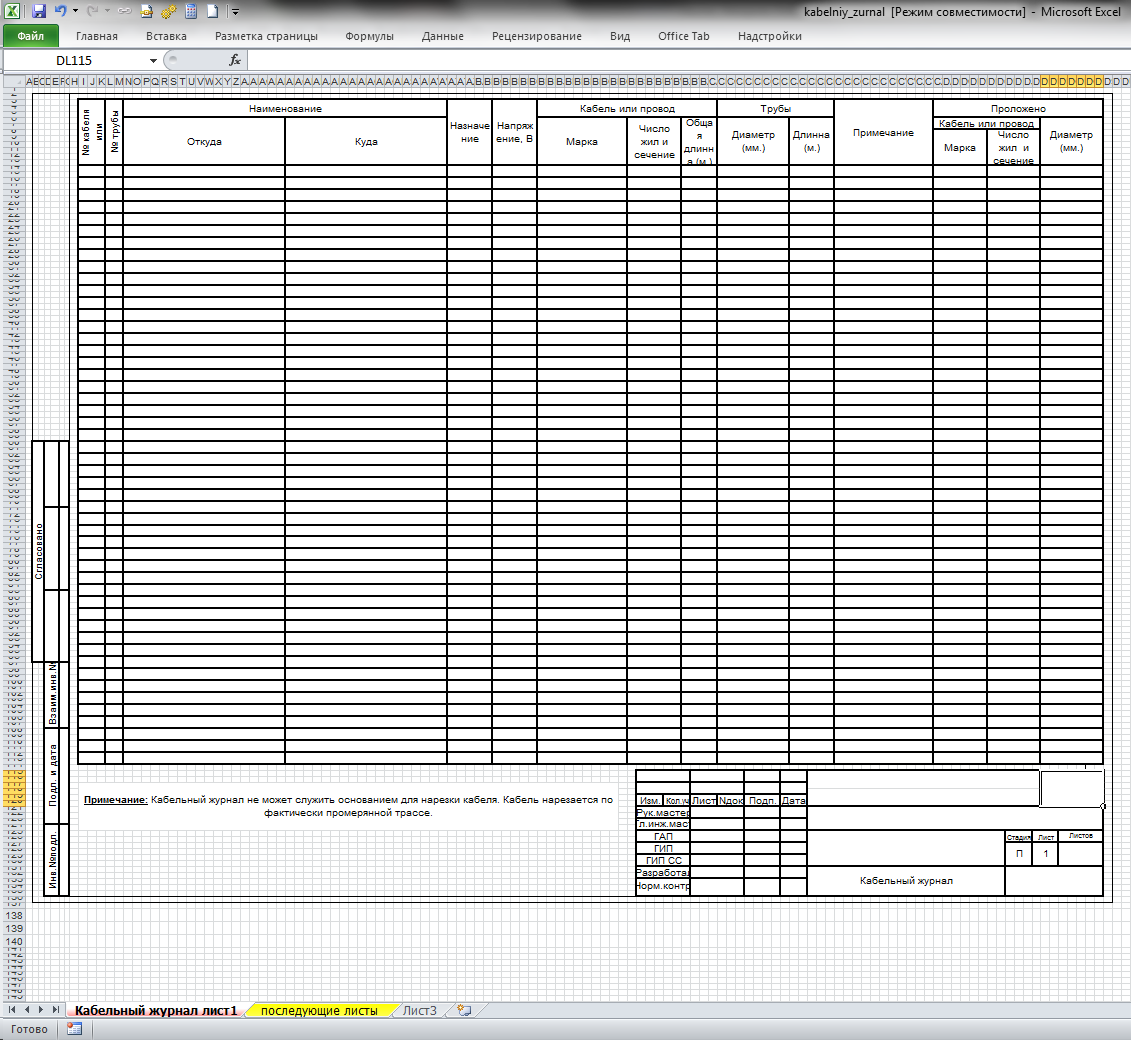
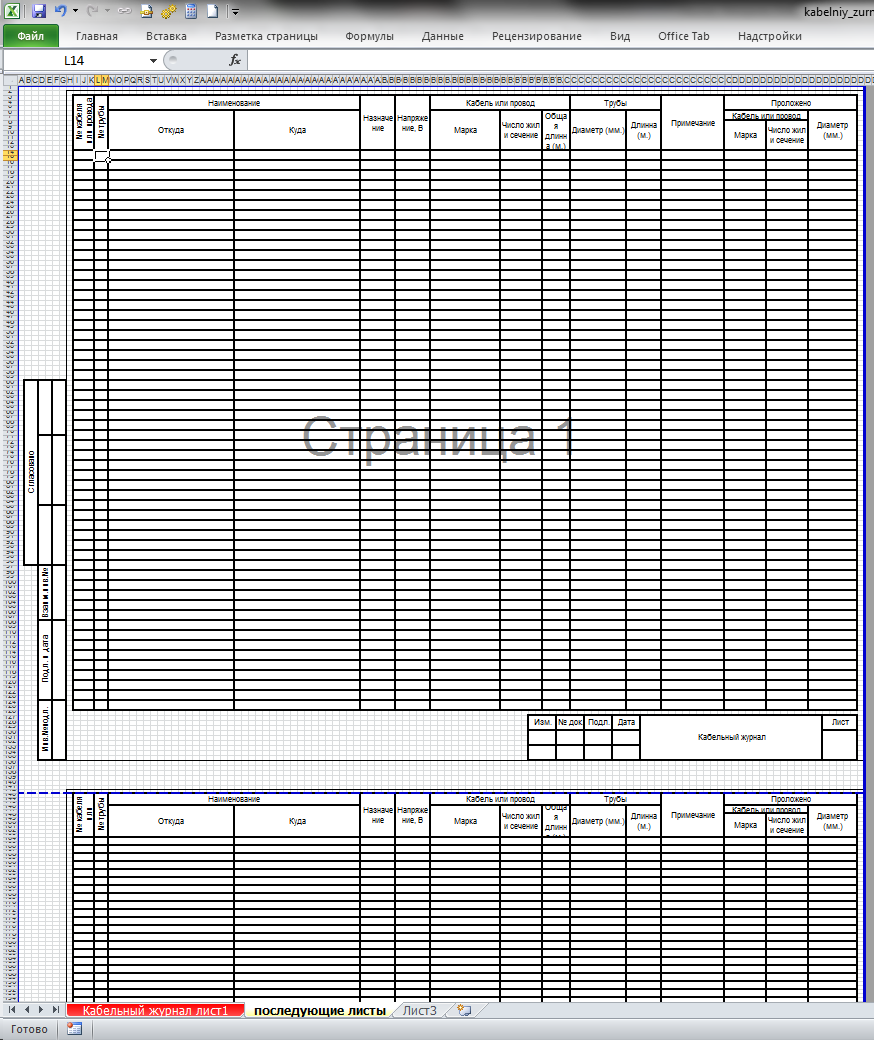
Separately the first sheet, separate subsequent sheets. The inconvenience of this method is that the table is broken, which means that using Excel functions causes certain difficulties, and filtering is generally impossible.
This method is still used today, and the screenshots show a fairly recent example from one of the Internet forums for designers. It is difficult to understand what GOST this magazine is based on. Apparently, the man himself came up with this form.
3. Compilation and design of a cable magazine in Word
The third way is to compile and design a cable magazine in Word. Working with tables in Word is not as convenient as in Excel, but the design is much easier. True, in order to make it convenient to work, you need to know and be able to use the “Header and Footer” tool, otherwise the design will “slide out”.
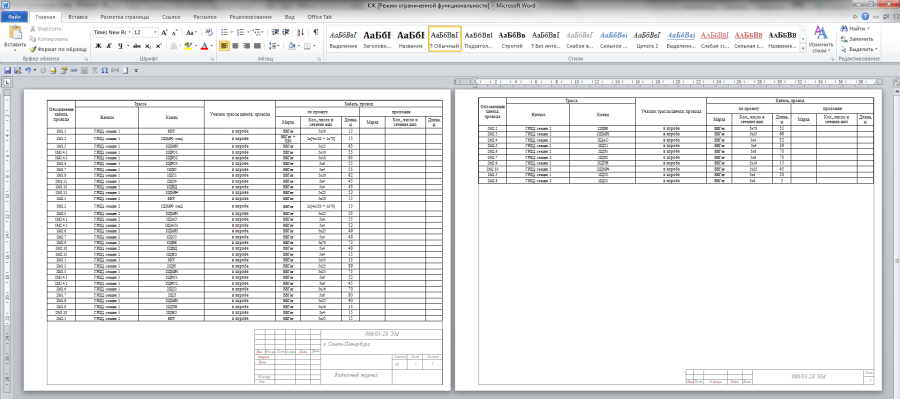
4. Drawing up and designing a cable magazine in AutoCAD
In fact, this method should be divided into two: before the appearance of tables in AutoCAD and after the appearance of tables. Before the advent of tables, this method was less convenient than in Word, because the table was a set of lines and text. And then everything depended on the skill and method of execution of the drawings by the designer:
- Drawing and design in Model space;
- Drawing and design in Sheet space;
- Drawing in Model space and design in Sheet space (one drawing - one sheet);
- item 2 or item 3, but all drawings are drawn up on one sheet.
The most convenient method is No. 3, because... allowed to make a continuous table in Model space, and then “cut” it into sheets using viewports.
With the advent of the “Table” element in AutoCAD, the fuss with lines and texts is gone, but otherwise, everything still depends on the way the drawings are made.
However, on one of the forums I saw a mention of another method. The designer made a line of the cable log as a block with attributes. And then he assembled a cable magazine from such blocks. He invented this method because... “switching lines in this case is much faster”.
5. Compiling a cable log in Excel and designing it in Word
This method combines the convenience of filling out a cable log in Excel and the convenience of formatting it in Word. The cable log is filled out in Excel and inserted into Word, in which the frame and main inscription (stamp) are made in the footers. Next, the width of the columns is adjusted and the cable magazine is ready for printing.
It would seem that the disadvantage of this method is the need to first delete the old table each time, and then insert and configure a new one. But it is not so. Word allows you to link a Word table and an Excel table. Thus, when you update data in Excel, the table in Word will also be updated.
6. Drawing up a cable log in Excel and design in AutoCAD
With the introduction of the Table element in AutoCAD and the ability to link it to Excel tables, this method is the best of the list.
Firstly, filling out a cable log table in Excel, in addition to convenience, provides additional benefits (see Tricks for creating a cable log in Excel).
Secondly, data from Excel is automatically updated in AutoCAD.
Thirdly, the AutoCAD table has the ability to automatically “split” into several fragments, which makes it possible to quickly and easily design a cable log in separate sheets (both using the table method in Model space, sheets in Sheet space, and using the table and design method in Model space). The interval between fragments, as well as the height of fragments, are set in the table properties.
Fourthly, when designing a cable log in Sheet space, the cable log can be included in the sheet binder, which provides additional advantages.
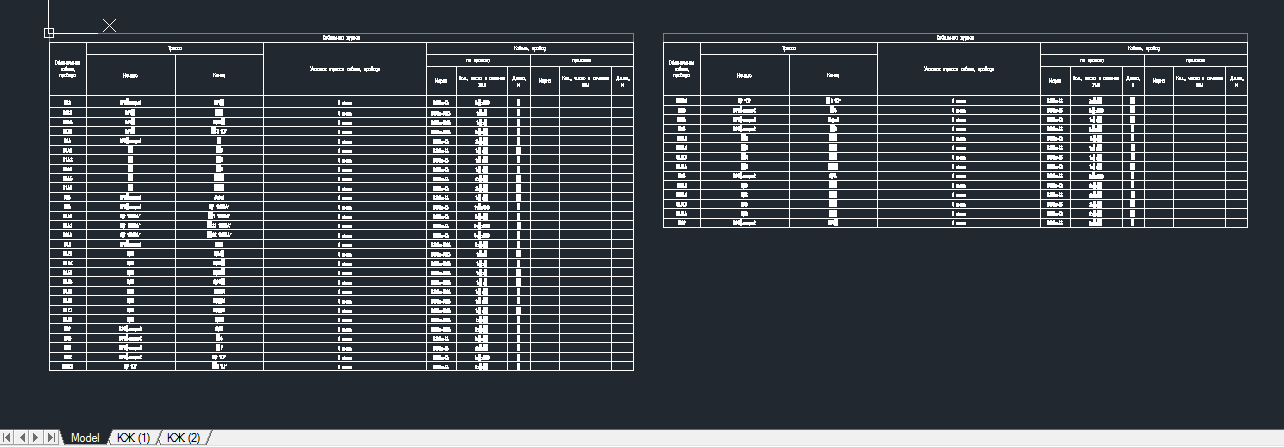
Article: 00801038
Year: 2015
Format: A4
Binding: Paperback
Bonding method: Clip
Pages: 10 (sheets: 20) (Recommended 60 pages
)
Sewing-adhesive bonding
?
Sewing binding
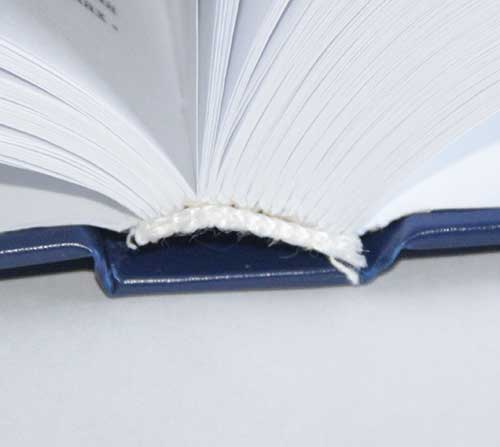
(makes binding more durable)

Number, lace, seal: ?
You receive printed products numbered, laced and prepared for sealing in accordance with the current regulatory documents:
The cost of lacing and fastening is 39 rubles.
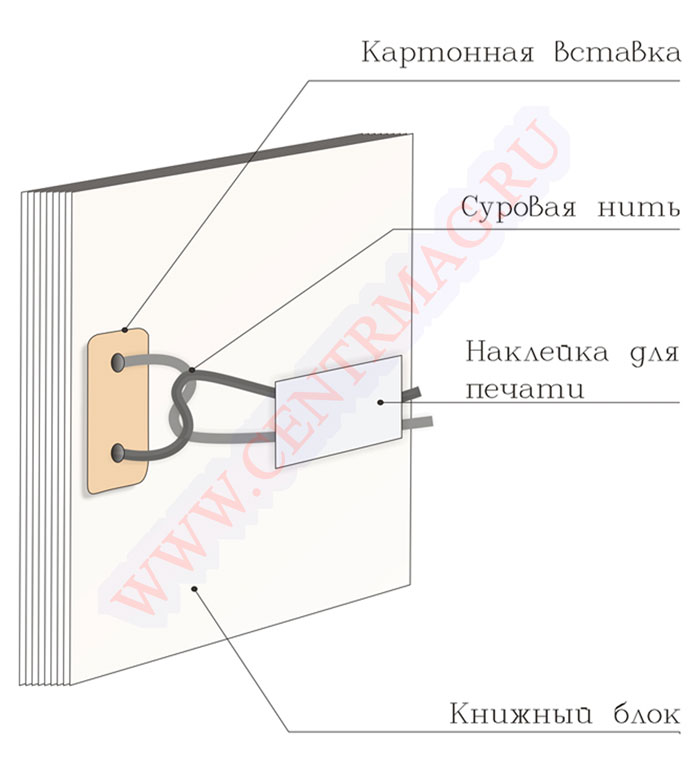
?
Page numbering starts from the title page to the last page of the magazine. Page numbers are located in the lower corners of the magazine.
?The magazine block is punched with two holes with a diameter of 6 mm, which are located at a distance of 80 mm from each other, from the spine side in the middle of the magazine. 
?
The magazine is laced with a special lavsan thread threaded through the holes of the hole punch. Secure with a cardboard insert and a printable sticker. 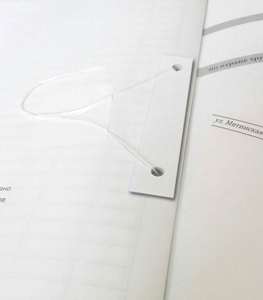
Number, lace, seal: ? According to the Decree of the Government of the Russian Federation of April 16, 2003 N 225 “On work books” Receipt and expense book for accounting of work book forms and inserts in it And book of movement of work books and inserts in them must be numbered, laced, certified by the signature of the head of the organization, and also sealed with a wax seal or sealed.
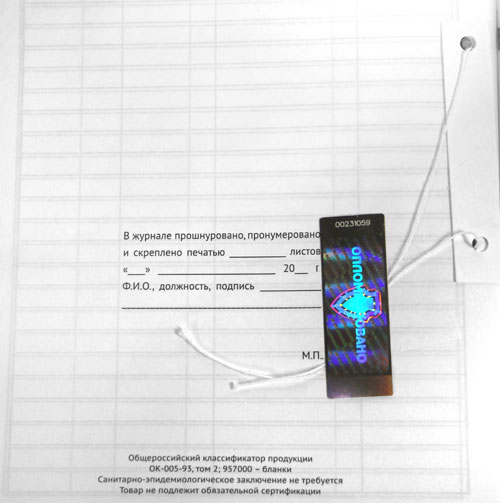
More about softcover Softcover- one of the most inexpensive and quickly produced bindings.
The binding cover is made of thick paper with a density of 160 g/m2; at your request, the cover can be laminated.
After the cover is ready and the block is printed, they are fastened with a paper clip, and if there are more than 60 pages in the block, then the bonding is carried out using a hot-melt adhesive machine.
Soft binding, due to its ease of execution and affordable price, is the most popular and one of the most affordable types of binding.




